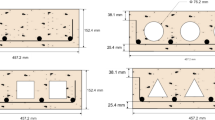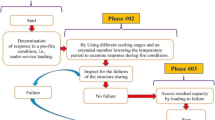Abstract
Concrete being the most versatile and widely used construction material finds application in varied range of structures. Many of these like chimneys, furnaces and reactors have to sustain high temperatures and perhaps all structures have to perform at elevated temperatures in the event of fire accidents. Concrete at elevated temperatures undergoes changes in its physical structure and chemical composition and loses its strength characteristics. Need for quick assessment of fire damaged concrete for strength characteristics, has motivated this work, which explores the potential of drilling resistance test on concrete as a Non Destructive Testing (NDT) tool. Drilling times, penetration depths and sound level measurement while drilling have been recorded and analysed to provide monograms that are handy as reckoners in failure forensics.
Similar content being viewed by others
References
Cioni, P., Croce, P., and Salvatore, W., Assessing fire damage to r.c. elements, Fire Safety J., 2001, vol. 36, no. 22, pp. 181–199.
Kulkarni, K.S., Yaragal, S.C., and Babu Narayan, K.S., Forensic engineering of fire damaged concrete structures: state of the art, Int. J. Forensic Eng., 2013, vol. 1, no. 3–4, pp. 342–354.
Bungey, J.H. and Soutsos, M.N., Reliability of partially-destructive tests to assess the strength of concrete on site, Construct. Build. Mater., 2001, vol. 15, no., pp. 81–92.
Chagneau, F. and Levasseur, M., Control of building materials by dynamostratigraphy, Mater. Struct., 1989, vol. 22, no. 3, pp. 231–236.
Zborovjan, M., Lesso, I., and Dorcak, L., Acoustic identification of rocks during drilling process, Acta Montanistica Slovaca, 2003, vol. 8, no. 4, pp. 91–93.
Miklusova, V., Usalova, L., Ivanicova, L., and Krepelka, F., Acoustic signal-new feature in monitoring of rock disintegration process, Contributions Geophysics and Geodesy, Spl. Iss., 2006, pp. 125–133.
Vardhan, H., Adhikari, G.R., and Govindaraj, M., Estimating rock properties using sound levels produced during drilling, Int. J. Rock Mechan. Min. Sci., 2009, vol. 46, no. 3, pp. 604–612.
Rajesh Kumar, B., Vardhan, H., and Govindaraj, M., Sound level produced during rock drilling vis-a-vis rock properties, Eng. Geol., 2011, vol. 123, no. 4, pp. 333–337.
IS 8112, Ordinary Portland Cement, 43 Grade-Specification, BIS, IND, 1989.
IS 4032, Method of Chemical Analysis of Hydraulic Cement, BIS, IND, 1985.
IS 2386, Methods of Test for Aggregates for Concrete, BIS, IND, 1975.
IS 383, Specification for Coarse and Fine Aggregates from Natural Sources for Concrete, BIS, IND, 1970.
ASTM C 192-90a, Standard Practice for Making and Curing Concrete Test Specimen in the Laboratory, ASTM, USA, 1994.
IS 516, Methods of Tests for Strength of Concrete, BIS, IND, 1959.
Ersoy, A. and Waller, M.D., Drilling detritus and the operating parameters of thermally stable PDC core bits, Int. J. Rock Mechan. Min. Sci., 1997, vol. 34, no. 7, pp. 1109–1123.
Neville, A.M., Properties of Concrete, 4th Ed., Essex, UK: Addison-Wesley Longman, 1995.
Hertz, K.D., Concrete strength for fire safety design, Magazine Concrete Res., 2005, vol. 57, no. 8, pp. 445–453.
Author information
Authors and Affiliations
Corresponding author
Additional information
The article is published in the original.
Rights and permissions
About this article
Cite this article
Kulkarni, K.S., Yaragal, S.C., Babu Narayan, K.S. et al. Assessment of thermally deteriorated concrete by drilling resistance test and sound level. Russ J Nondestruct Test 53, 805–815 (2017). https://doi.org/10.1134/S1061830917110031
Received:
Published:
Issue Date:
DOI: https://doi.org/10.1134/S1061830917110031




